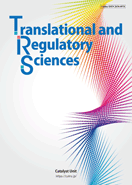Volume 5, Issue 2
Displaying 1-3 of 3 articles from this issue
- |<
- <
- 1
- >
- >|
Full Paper
-
2023 Volume 5 Issue 2 Pages 28-35
Published: 2023
Released on J-STAGE: August 20, 2023
Advance online publication: July 03, 2023Download PDF (1545K) Full view HTML
Review
-
2023 Volume 5 Issue 2 Pages 36-39
Published: 2023
Released on J-STAGE: August 20, 2023
Advance online publication: June 09, 2023Download PDF (752K) Full view HTML -
2023 Volume 5 Issue 2 Pages 40-52
Published: 2023
Released on J-STAGE: August 20, 2023
Advance online publication: July 27, 2023Download PDF (1813K) Full view HTML
- |<
- <
- 1
- >
- >|
